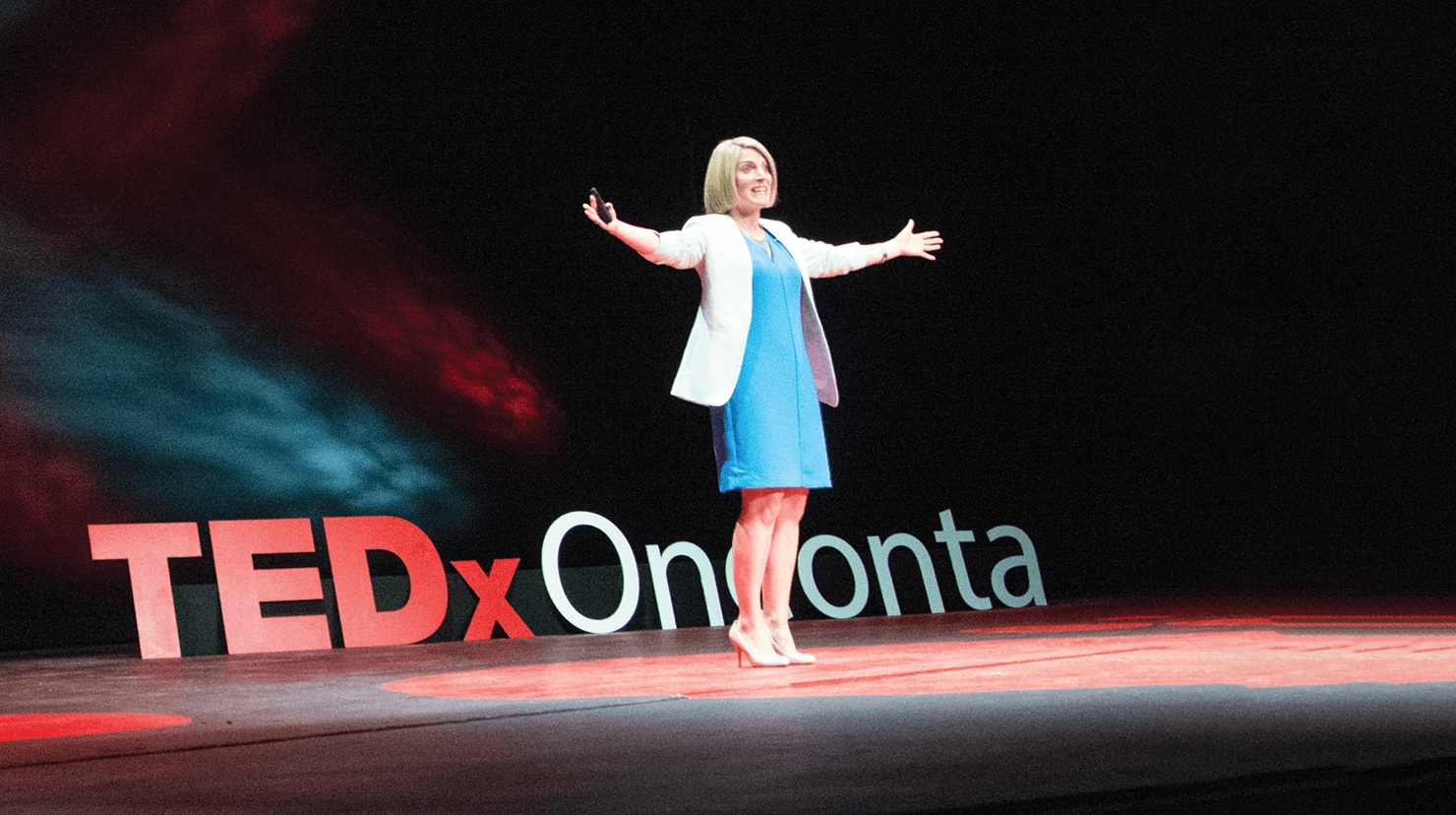Funny thing about people. We try to avoid pain more than we strive for gain. Most people tend to focus on the negative rather than the positive. I believe that’s the reason why the number one question I get when coaching clients to give a TED Talk is: “What am I doing wrong?” rather than “What am I doing right?”
Let’s talk about pain for a minute. A lot of people struggle with the pain of public speaking. Where does that pain come from? It’s a fear of feeling vulnerable in front of other people. Would we feel as vulnerable if we knew we could execute a presentation flawlessly? No. We are afraid of making mistakes and looking silly. What if we could avoid that pain by learning from the most common and often simple mistakes that we all make.
As a TED coach and an executive speaker coach, I spend much of my time researching and incorporating the psychology of audience engagement and interaction into my work. I teach clients how to create talks, speeches, and presentations that aren’t awful, because no one wants to be awful. The goal isn’t to avoid it; it’s to rock every speech, presentation, or talk we give.
But, how do we do that?
Mistakes We Make the Most
The quickest way to a boring presentation that lacks creativity is to allow yourself to fall into the common pitfalls you have undoubtedly witnessed firsthand. It’s easier to scarcely prepare than to roll up your sleeves and work hard to deliver a unique and polished presentation.
Let’s start with the “no-no’s.” There are many cliché habits we imitate in our presentations because we’ve seen and heard them before. How many times have you heard one of the following: “And without further ado…” “Let me start by thanking the organizers for having me here today.” “Thank you for your time. I’m honored to be here with you.”
Not that any of these sayings are bad—they aren’t. They’re just overused and expected. As a speaker, you can assert your power, and ultimately influence, by working a little harder to be original.
I have coached a wide variety of speakers: from a rap singer to a World War II veteran, from CEOs to TED speakers and Toastmasters World Champions. I’ve watched, analyzed, and reverse-engineered oh-so-many presentations. I started compiling a list of the most common mistakes that people make. Of course, I won’t just leave you with a list of no-no’s. I’m a coach. I’ll also tell you what you can do to rock it instead.
Here are the top 10 mistakes that can dull down and suck the “wow” out of any presentation, followed by ways to turn the mistakes into wins.
1 Infowhelm
Don’t overwhelm your audience with too much information. There’s only so much they can process at once. They don’t need hordes of data to get behind what you’re saying. They need the right amount of information with the right angle.
How to rock it:
Be selective about the information you use and tailor it to your audience's needs, not to your own expertise or comfort level.
2 Being audience ignorant
There are many ways we can be audience ignorant, particularly when we present information that doesn’t match the interest or maturity level of our audience. Leaders want the 30,000-foot view while analysts love to get into the weeds. Colleagues in your field might want to see your work, while a potential client might want to just hear the conclusions. Don’t be oblivious to what your audience cares about.
How to rock it:
Figure out the best way to connect with your audience by focusing on what they care about. Put yourself in their place. There’s always an invisible wall between you and the audience. It’s your job to recognize it’s there and bring it down.
3 The slow start
Have you ever heard a presentation start where it takes a while before the speaker gets to the point? Slow starts are terrible. You should always open strong and grab the interest of your audience immediately.
How to rock it:
A great way to open is to ask an intriguing question or make a shocking statement. Do something that will instantly capture and retain the attention of the audience. One caveat, though: Don’t do something just to do it. Make sure that your opening ties strongly to the ideas, points, and call-to-action you will be presenting.
4 Over-explaining
Have you ever heard someone tell a story and they go on and on and on and on? By the time they were done, you asked yourself, “What was the point of that?” Or, they explain an idea or concept and give more information than what was needed.
How to rock it:
Keep your stories and explanations as short as they can be. Do more engaging and less explaining. If you pay close attention to the reaction of your audience, you’ll know when you’re over-explaining.
5 Sameness
Most people can’t handle listening to someone who doesn’t have variety in their delivery of a presentation. In other words, sameness. If you sound the same throughout your speech, the audience will stop paying attention. The same of anything gets boring.
How to rock it:
Be aware of how you sound and your audience’s reaction. Add variety to everything—pace, vocal range, volume, and even the emotions you inject. Take your audience on a captivating journey where nothing stays the same. This will keep them tuned in the entire time.
6 Ending on Q&A
Never end on audience questions. You have no control over what’s being asked, so a question coming out of left field could derail your whole message and change the energy in the room. That’s not how you want to close, so don’t gamble on someone else’s question.
How to rock it:
Do the old radio show trick. When you get close to the end of your presentation, set the audience up with a teaser of something for them to look forward to at the end, then launch into the Q&A, before shifting gears into an impactful and memorable close.
7 Going over time
The cardinal sin in public speaking is going over time. It’s not enough to stay within your allotted time. Pace yourself so you don’t end up on slide seven out of 30 with a few minutes to go. A great way to derail a presentation is to make the audience feel anxious as you race to beat the clock.
How to rock it:
Internalize your presentation. If you know it backward and forward, you can easily cut something out on the spot. Improvise to make an “emergency landing.” Do whatever you have to so the audience feels they got what they needed rather than feeling their time was wasted.
8 Dreadful visuals
There is no such thing as a neutral visual—it’s either adding or taking value away. If a visual is tied to a point or story in a powerful way, it can be extremely effective. If a visual is boring or cliché, then part of your presentation is as well. Avoid clip art (pre-made images for a variety of mediums), stock photography, or slides with too many words.
How to rock it:
Find the visual that will connect your audience emotionally to what you’re saying. If you’re telling a story about how your grandma used to make homemade ravioli, don’t show a stock photo of a plate of ravioli. Show us a picture of your grandma, or even better, one of her making ravioli.
9 I before you
Many presenters make their stories all about them. Yawn. Do you want your audience to tune out? If so, make your presentation all about you. If not, then don’t.
How to rock it:
Here’s a useful exercise: Count how many times you say the word “I” and how many times you say the word “you” during your presentation, then flip your wording. For example, change “I went to the store at 2 a.m. because I was craving my favorite ice cream” to “Have you ever gone to the store at 2 a.m. because you were craving your favorite ice cream?” When you use the word “you,” it makes your audience put themselves into your story. They would rather think about themselves than hear you ramble on about what you did or what you think. Keep the I/you balance tipped more toward them than you.
10 The weak finish
The last thing that you say is the most important. At the end of your presentation, what do you want to leave your audience with? Do you want them to do something, change something, or think differently about something? Your biggest opportunity for a strong call to action is at the end. The mistake many people make is ending weak. I’ve always thought that ending with a “thank you” is just a lazy way to say, “My presentation is over.” Find a better way.
How to rock it:
Think of your ending like a closing argument. Whatever you want your audience to do, think, or feel, make that apparent in your closing. Create an ending that will be so compelling and so obvious that the audience doesn’t need the cue of “thank you” to know you are finished.
Focus on what works
Will anyone ever be able to completely eradicate mistakes out of their presentations? No. But you can focus on what works. Sometimes what works for one audience won’t work for another. Awareness of these mistakes is just the start; ultimately, the audience wants to hear your unique content and feel your confidence. Find the intersection between what you are knowledgeable about and what works for your audience. Remember, every time you speak it’s for them, not for you.
Anything is a mistake if it doesn’t work. Honing your craft and being aware of what doesn’t work can help you find what does work.
Cathey Armillas, DTM has been a Toastmaster for 20 years. She is a Past District Director and three-time DTM. She is also a world-renowned speaker coach who runs a successful business coaching CEOs, business leaders, and TED speakers on delivering talks and sharing their stories. Find out more at catheyarmillas.com.
Related Articles

Personal Growth
How I Prepared for 18 Make-or-Break Minutes

Presentation Skills



 Previous
Previous
 Advice From the Experts—In 6 Words
Advice From the Experts—In 6 Words
 Previous Article
Previous Article
